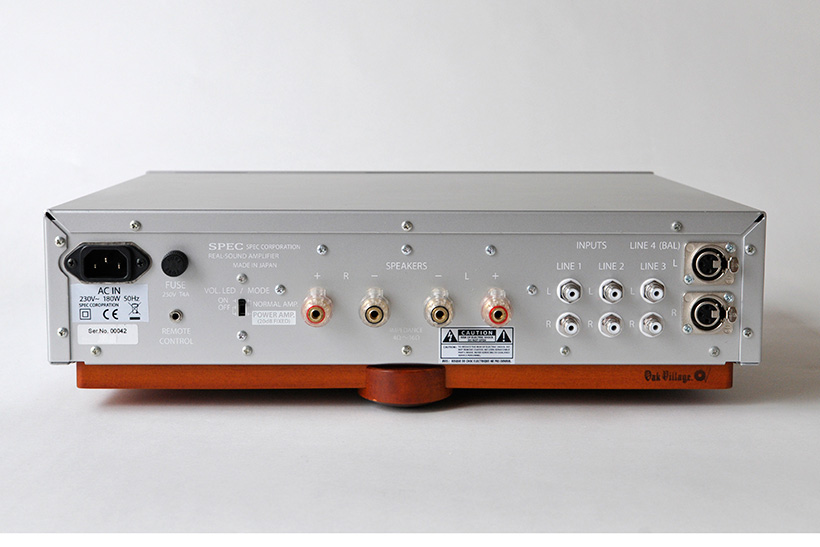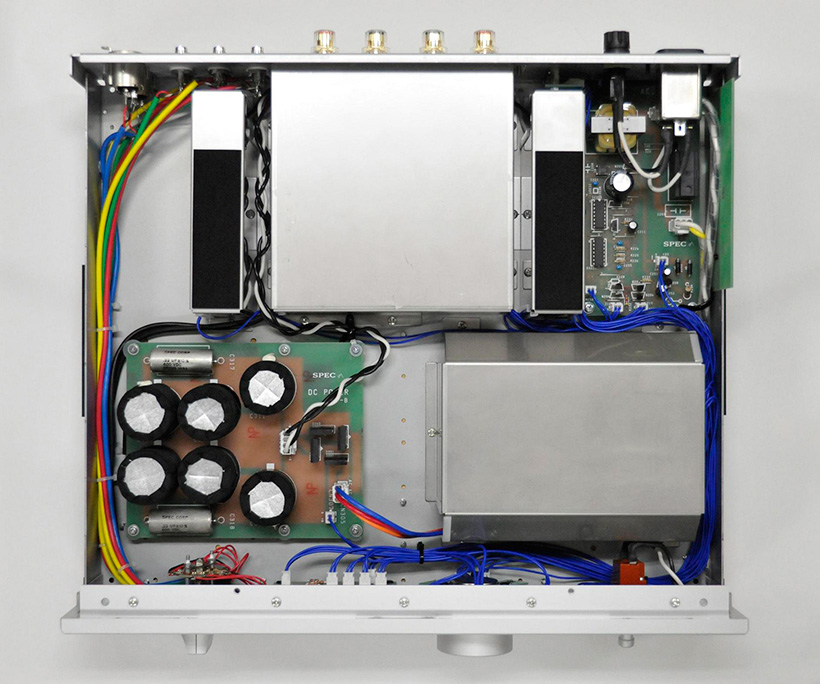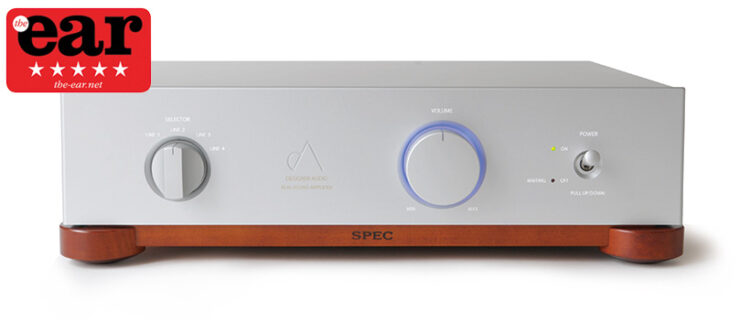I am always curious about what new brands and/or technologies have to offer, so when I got the chance to hear a SPEC amplifier at home I didn’t say no. I picked the Real Sound Amplifier RSA-M3EX, the middle model in the range. I had not heard of the brand or the designer so took a look on the internet to see what they had to offer, this piqued my interest and in my enthusiasm I changed my normal writing procedure. Usually I start with a description followed by the listening impression, but when a product is very good I start with the sound. Well, the SPEC RSA-M3EX is just such a product.
Matching
Trying to find the best possible match between components is a part of the review process that’s not often told in detail, but sometimes it’s interesting enough to go into. My first set-up was in a smaller room with a pair of Harbeth P3ESR loudspeakers. Playing music was not as spectacular as promised by the distributor and the company leaflets. In fact I could not relate the high price with the performance although I could hear that something special was trying to get out. I missed power, speed and low end energy. Music sounded nice and full of detail, but drums were slow, there were no rumbling bass notes and electronic music had none of its impact. Only the stereo image was very well defined and full of space, putting the accent on the midrange and thus voices. After extended listening I reached the conclusion the speed was not an issue at all and the lack of bass notes had more to do with the chosen loudspeakers than anything else. The Bass might not have been overwhelming, but they came out tight and pure. More pure than results with other amplifiers in the same room and set-up. The perceived lack of drive changed into an admiration of the pure and open sound. With every listening session I got more and more convinced that the SPEC needed far bigger loudspeakers with a higher efficiency to prove its worth.

Who am I, not to move the amplifier into my main listening room and connect a pair of PMC fact.12 transmission line speakers? I enjoyed the SPEC before but this was a new era and I never looked back. The power I missed was there in spades, listening to the sound effects used in movies it was now possible to feel the fear. Bass engulfs the room whilst remaining surprisingly tight, the grip on the loudspeakers showing just how much power this amplifier has to offer. Speed is no longer an issue and drums explode into the room. All my initial reservations about the RSA-M3EX were blown away and it was time to further investigate the real beauty of this integrated amp. The PMC speakers seem to disappear from the room given a decent source and a nice amplifier, there’s no need to close your eyes for that. But the room acoustics and the setting of the speakers in a room that doubles as a space for the family make it a lot harder to create a deep stereo image. Like so many listeners I moved my loudspeakers into a position to get the best compromise and to create a good environment to judge audio components in. In my experience some amplifiers and sources cannot create a deep and wide soundstage in this room, but the RSA-M3EX is just the opposite, creating an enormous virtual stage for musicians to excel in solos against other band members or in front of an orchestra. The image reaches from one side wall to the other, and from floor to ceiling, with a back wall that’s no longer audible and a more forward moving sound. But the music doesn’t slam you in the face, the stereo image the RSA-M3EX creates is the one you have been looking for so many years. Time after time instruments and vocalists perform and there seems to be no preference for a particular genre. Searching for minor limitations I notice that on a CD like Live In The O2 Arena by Katie Melua my own amplifier shows a little more of the atmosphere from the large hall. At the same moment I realise that the combination of speaker and amplifier is one, as slave and master in start/stop behaviour. Some amplifiers tend to create another illusion of space by being a little slower, so which one is right? I do not know and the differences are small.
More music
Small jazz combo’s benefit from a system with speed and transparency. The Bobo Stenson Trio’s album Cantando is a good example. Percussion forms an important part of this music and the RSA-M3EX loves it. The drum kit is hit hard, Glockenspiel tingles into the room and cymbals sizzle. Smaller and bigger drums exchange places in an organized barrage. A plucked bass follows the line and piano stands out playing its own solo. The musicians seem to enjoy what they play and the SPEC projects this feeling towards the listener and very soon my feet tap out the rhythm. It makes me realize how natural, rich, pure and musical the sound of this class D amplifier is. The SPEC RSA-M3EX is the first amplifier without the specific class D character that bores me over time, a colouration that turns music into a technical excercise. No manufacturer has overcome this until now, and in advance of a formal conclusion I dare to state that this is the first and only amplifier of this kind that I could live with.

‘The Bug’ by Dire Straits explodes with hammering percussion, Mark Knopfler in front of the band, drums behind him, guitars to the left and right of the soundstage and backing vocals between the singer and the band. Fast sounding and lacking only a bit of the weight more powerful amplifiers can offer. The RSA-M3EX is about purity, musicality and minimal distortion rather than being a power plant. High efficiency loudspeakers with or without minimalist damping like a pair of Russel K. Red 100 would turn your hi-fi system into a high quality PA system for instance, while my PMCs love and need more power. A Loreena McKennitt performance for German radio called ‘Troubadours On The Rhine’ is extremely well recorded. The dynamic expression within her voice shows the range of the SPEC, shows how low the dynamic noise floor is. Lesser amplifiers modulate the noise with the loudness of the music, making music tiring and restless. The acoustic instruments in the band and McKennitt herself add to the atmosphere and pureness that the RSA-M3EX creates, grabbing the listener’s attention time after time. When the track finishes and the public in the studio applauds a “thank you” from Loreena sounds uncannily real. Unique? No, maybe not, but good proof of the designer’s craftsmanship.
Luo HaiYing sings in Chinese with backing from big drums. These drums need power, despite the SPEC’s 60 Watt rating this is no problem thanks to a heavy power supply and large capacitors, and it produces a wonderful stereo image. Musica Antique Nova by Rachel Podger is even better, her violin almost sings in the listening room. The words subtle, rich and pure come to mind. There’s absolutely no stress in this amplifier, you simply enjoy the performance without any reference the to technology inside the box. It’s hard to listen to what the amplifier does, much easier to enjoy the results. Music is the winner, especially when Dame Kiri Te Kanawa starts singing ‘Madame Butterfly’ accompanied by a large orchestra, the amp’s capabilities seem limitless. Looking for specific class D shortcomings I cannot find any, no matter how hard I try. Is this amp the best ever or do I still want more? Naturally the SPEC does not have the limitless power and authority that my 250 Watt class AB amp delivers, and a bit more air around the musicians would be welcome, just a bit. Why am I looking for shortcomings? Because I do not want to be tempted to buy a SPEC to be honest. Dreaming away again with a piano concert from Mozart played by Kristian Bezuidenhout, it’s a luxury to imbibe music this way.

RSA-M3 EX
The SPEC looks simple with just source, volume and a nice power switch on the front, and inputs, speaker terminals, a switch to illuminate the volume control and a small switch to use the RSA-M3EX as power amp on the back. A 3.5mm bus is available for the two part remote control; receiver and a handset. The bottom of the amplifier is made of wood with integrated feet. The aluminium housing with the spruce base and its maple and hickory feet makes an attractive combination. The amplifier delivers 60 Watts into 8 Ohms and the frequency range resembles that of a tube amplifier, 10Hz – 30Khz ±1dB (6Ω, 1W). Under the hood the SPEC differs from most other class D amplifiers, it has a PWM engine triggering MOSFET switching power transistors, a technique developed by International Rectifier in the US. The power supply has a big R-core transformer and silicon-carbide Schottky diodes. Capacitors are used in a carefully matched mix of electrolytic and paper-in-oil types of different values for the best audio results. The output filter uses a coil specially developed for audio by listening and a combination of paper-in-oil plus silver-mica capacitors, especially made for SPEC by Arizona Capacitors Inc. As SPEC states, the RSA-M3EX is actually made like a tube amp but with class D modules instead of tubes.

Who is SPEC
SPEC designer Shirokazu Yazaki (above) started his career with TEAC Japan, where he stayed for four years developing amongst other things the TEAC A-37300 reel-to-reel recorder, before he went to Pioneer for the following 17 years where he worked on the CT range of cassette recorders and the ‘legendary’ DV-AX10 DVD/CD/SACD player. His interested in class D was aroused because his old Pioneer colleague Jun Honda works for International Rectifiers producing power management solutions where he makes the audio modules used in SPEC amplifiers. Yazaki-San has been using single-ended triodes and horn loaded loudspeakers for decades, an enthusiasm inspired by a Jean Hiraga demonstration of Altec horn loudspeakers driven by a DA30 triode based amplifier in 1971. From that moment Yazaki-San became fascinated with the DA30, which he prefers over a 300B, always trying to improve his own designs through listening and research with horn loaded loudspeakers from Altec, JBL and Onken. History was written in February 2010 when the SPEC Corporation was formed by Shirokazu Yazaki and Jun Honda, to bring to the market class D amplifiers that are just as good or even better than the DA30 tube designs that had taken over 40 years to perfect. Yazaki-San points out that the moving coil of a loudspeaker develops energy that returns to the output stage of an amplifier to influence the feedback circuit by creating distortion. In a class D amplifier this energy is absorbed not in a feedback circuit but in the power supply, where it is harmless. Which, he says, is one of the reasons why class D amplifiers sound so pure and clear.

Finally
After an enthusiastic review the conclusion can only be positive for the SPEC RSA-M3EX amplifier. I had to get used to the amp, it first seemed a little plain and underpowered compared to my own amplifiers. An opinion that soon needed adjustment and turned 180 degrees into appreciation of its pure, delicate and undistorted sound quality. Deep bass notes might seem to lack power at first, but soon I found out that bass is so tight, fast and uncoloured that it only attracts less attention. This was even clearer after changing from small monitor speakers to large transmission lines. Also consider the near perfect stereo image of the RSA-M3EX, the spatial sound and the purity of the reproduced music. Every class D amplifier I have heard had a specific class D signature that I could never get used to, I always returned to more conventional designs with a preference for class A. That is until I listened to the SPEC RSA-M3EX, an amplifier that makes me forget the technology and sounds so good that I would like to own one. It’s my first encounter with class D technology that offers high end sound quality in the true sense. I realise I probably make more enemies than friends with these words, so be it. A final word: I often get the impression that Japanese high end products have a soul, a part of the designers aura stays under the hood. The SPEC is among these products, Shirokazu Yazaki has me under his spell.


